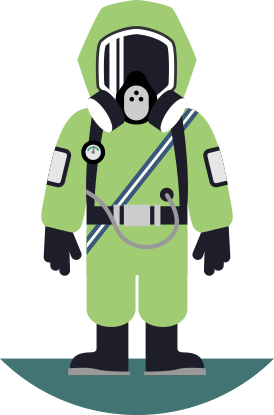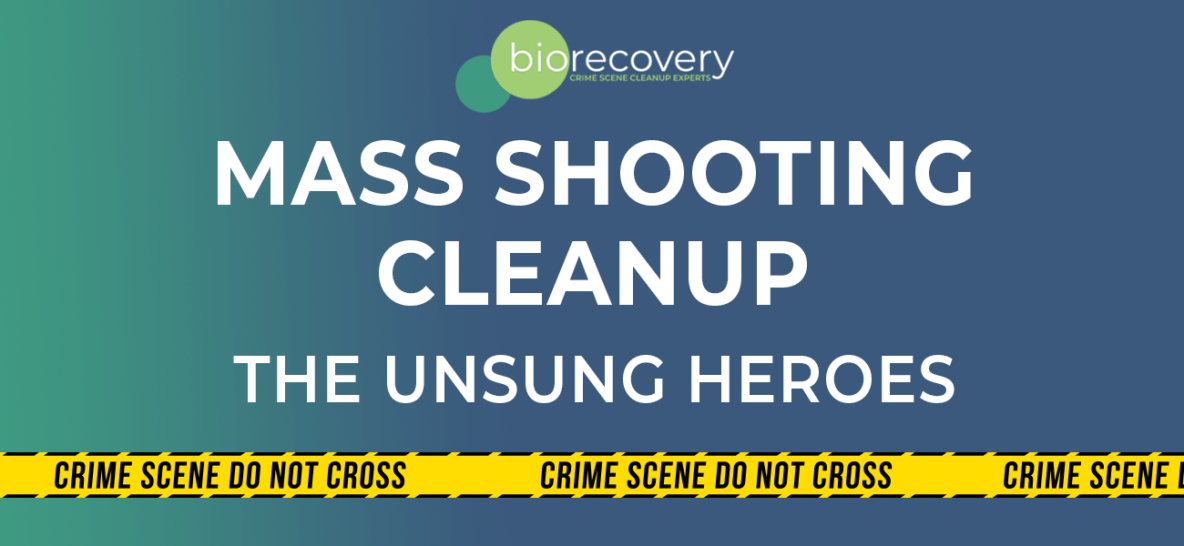There is no standard death toll by which to qualify a “mass shooting”. The simplest definition would be an event in which an individual opens fire on a group of people, usually at random, with the intent of causing as many fatalities as possible.
But who performs the gruesome mass shooting cleanup after the victims are carried away and the media has moved on to the next big story? What’s involved in such an unimaginable job?
The Little-Known Role of Crime Scene Cleanup Experts

We don’t think it’s morbid to wonder what such a scene may look like, especially when we, as empathetic humans, try to imagine what the victims experienced during the attack. Like many steps in the healing journey, it’s uncomfortable to talk about. Which is why we thought we’d shed some light on what some may incorrectly call a “ghoulish” topic: Who cleans up after a terrorist act or mass shooting?
Once investigators have released the scene of the shooting, mass shooting cleanup teams quietly take over to address the aftermath. These specially-trained technicians survey the immediate and surrounding areas for contamination and devise a clear plan of action that addresses the following problems:
- How to organize disposal of both biohazardous and standard waste
- Where to set up transition zones between contaminated and “clean” areas
- How to operate discreetly, without disturbing an already traumatized community
- How to work with law enforcement and public officials upon discovery of further evidence or significant human remains
- How to deflect and defer media and onlooker questions
Professional trauma recovery companies must be methodical in their processes and in compliance with EPA, CDC, and OSHA guidelines. Anything left behind poses a threat to the physical and mental well-being of future visitors and occupants, and improperly discarded material risks the health of waste management workers.
Untrained cleanup efforts can actually increase environmental hazards after a mass casualty event.
Biohazard Remediation Challenges Unique to Mass Shootings
EMTs and paramedics—focused on caring for and evacuating casualties under fast-paced and critical circumstances—leave behind bandages, trauma pads, gloves, victims’ clothing, and other contaminated items.
This is, of course, in addition to spilled blood, human waste, vomit, and residual tissues resulting from the gunshot injuries themselves. And then there’s teargas, gunshot residue, and forensics materials. All of these must be detected and removed, and all surfaces cleaned and sanitized, before secondary issues arise.
The longer the investigation lasts, the more complicated the cleanup becomes. Biohazardous material quickly attracts insect and animal pests. In open-air areas, scavenging birds can (and will) carry off contaminated materials, dropping them outside the designated cleanup area.
Rodents may move tissue or discarded items into wall voids and vents. The scent of decomposition also attracts flies and roaches.
While all of these challenges exist with small-scale decomposition cleanup projects, mass shootings tend to happen in larger areas expanded by emergency responders setting up triage and evacuation zones.
Even when large-scale tragedies play out on private property, contamination risks public safety. That’s why professional biohazard remediation companies play a critical role in containing and sanitizing trauma scenes.
The Psychological Challenge of Mass Shooting Cleanup

Any scene where violence and tragedy have taken place is difficult to face for those who have to clean up body fluids and other biological evidence, no matter how “hardened” they may be.
Mass shooting scenes require professional, experienced biohazard cleaning personnel who have been prepared to work in psychologically traumatizing settings. Death cleanup is never easy for our technicians, though we’re able to compartmentalize our feelings enough to get the job done. We take comfort in the knowledge that we’re performing a valued service and giving comfort to grieving families.
But when, like the rest of the world, we’ve watched the shocking news reports, it’s surreal to arrive at the scene in an official capacity. There’s where we saw the small body covered in a sheet. That’s where family members waited for news of their loved ones. And here’s the blood left behind when they carried away the killer.
We see details that not even high-definition television can detect. It’s our job to look for them, and the human remains left behind after high-velocity gunshots and explosions aren’t always where—or in the condition—you’d expect them to be.
Mass shooting cleanup professionals aren’t present when the crisis is actively unfolding, but biohazard cleanup teams perform heroic acts all the same. They can’t protect against gunshots, stabilize victims, or evacuate those in harm’s way, but they do make sure that secondary dangers such as bloodborne pathogens, pest infestations, and the shock of discovering remnant body tissue and blood don’t cause more emotional or physical devastation.
The Unsung Heroes in the Aftermath of Trauma
With the overwhelming frequency of mass shootings and other acts of terrorism, it’s too easy to forget the individuals lumped into categories: Victims. Survivors. Families of. Those who survive will carry the weight of the tragedy with them the rest of their lives. So will first responders, and so do we, as we silently work to prevent further harm.
Each time a mass shooting makes headline news, we at Bio Recovery join the world in grieving for all those who have been affected. But we’re also keeping our colleagues in our hearts, knowing that their job as a crime scene cleaner is one that’s never celebrated, if it’s recognized at all.
And we’re always looking to meet new heroes. If helping families and communities recover from tragedy appeals to you, and you embrace emotionally and physically challenging work, we invite you to look into a career as a trauma restoration technician. Contact us if you’re interested in learning more about our training opportunities.
Call Today
If you are in need of professional mass shooting cleanup services, contact Bio Recovery immediately. Call 1-888-752-5001 for 24/7 assistance.
